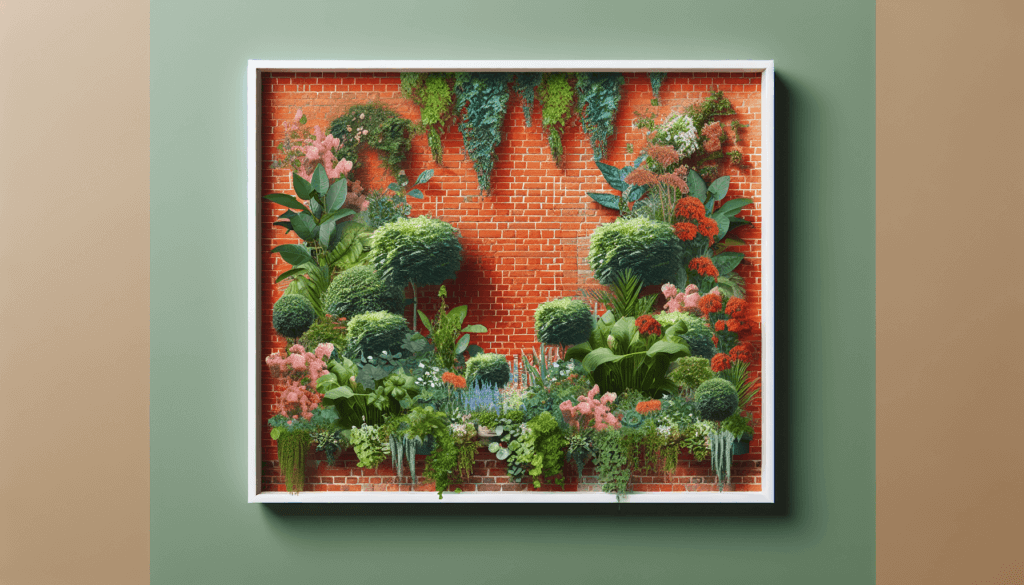Are you interested in gardening but don’t have a large yard or outdoor space? Look no further than vertical gardening! In this beginner’s guide, we’ll show you how to create a beautiful and thriving garden using vertical structures such as walls, trellises, and hanging baskets. With our tips and tricks, you’ll learn how to maximize your space and create a stunning garden oasis, even in the smallest of areas. Get ready to take your gardening to new heights with vertical gardening!

What is Vertical Gardening?
Explanation of vertical gardening
Vertical gardening is a method of growing plants vertically, using vertical space to maximize plant growth in a limited area. Instead of planting in traditional horizontal garden beds, vertical gardening allows plants to grow upwards in containers or structures such as trellises, arbors, or living walls. This innovative approach to gardening is perfect for those with limited or no garden space, as it utilizes walls, fences, and other vertical surfaces to create a beautiful and efficient garden.
Benefits of vertical gardening
Vertical gardening offers numerous benefits for both the gardener and the plants. Firstly, it maximizes the use of limited space, allowing you to grow a wide variety of plants even in small urban gardens or balconies. By utilizing vertical structures, you can optimize your growing area and make the most of every square inch available.
Secondly, vertical gardening provides better air circulation around the plants, reducing the risk of pests and diseases. The elevation of the plants helps to keep them away from the damp ground, which can lead to fungal issues. Additionally, vertical gardening allows for easier access to plants, making maintenance tasks such as watering, pruning, and harvesting more convenient.
Lastly, vertical gardening is visually stunning and can transform plain walls or fences into vibrant, living works of art. With a wide range of plant choices and creative designs, you can create a vertical garden that adds beauty and greenery to any space.
Types of vertical gardens
There are several types of vertical gardens to choose from, depending on your preferences and available space.
Vertical planters are an excellent option for indoor or outdoor gardening. These are freestanding structures with multiple planting pockets that can be easily mounted on a wall or placed on the ground. Vertical planters are versatile and can accommodate a variety of plants, from flowers and herbs to lettuce and strawberries.
Living walls, also known as green walls or vertical gardens, are vertical structures covered with plants. These can be created using a grid system or modular panels that are attached to a wall or freestanding frame. Living walls provide a visually striking display of plants and are perfect for adding greenery to urban environments.
Trellises and arbors are a classic option for vertical gardening and are particularly suitable for climbing plants such as vines, tomatoes, or cucumbers. These structures provide support for the plants, allowing them to grow vertically and save valuable ground space.
Choosing the Right Location
Considerations for selecting a location
When choosing a location for your vertical garden, there are a few essential considerations to keep in mind. Firstly, assess the available space and determine whether it receives sufficient sunlight. Most plants require at least 6 hours of direct sunlight daily, so select a location that offers adequate light for optimal plant growth.
Secondly, consider the accessibility of the water source. Vertical gardens may require frequent watering, especially during hot summer months. Ensure that the chosen location has easy access to a water supply, whether it be a nearby faucet, rainwater collection system, or a water tank.
Lastly, think about the overall visual impact of your vertical garden. Consider how it will blend with the existing surroundings and if it will complement the architecture or landscape. Choosing a location that enhances the overall aesthetics of the space will create a more appealing and harmonious garden.
Amount of sunlight required
Sunlight is a crucial factor in the success of any garden, including vertical gardens. Most plants require a minimum of 6 hours of direct sunlight per day to thrive. However, some plants, such as leafy greens or herbs, can tolerate partial shade and may only require 4-5 hours of sunlight.
When selecting the location for your vertical garden, assess the amount of sunlight the space receives throughout the day. Observe any potential shading caused by nearby buildings, trees, or other structures. If the chosen location is partially shaded, consider growing shade-tolerant plants or opting for a living wall setup that allows you to adjust the positioning of the plants to capture the most sunlight.
Access to water source
Proper watering is essential for the health and growth of your vertical garden. In most cases, vertical gardens require more frequent watering than traditional gardens due to their increased exposure to air and wind. Before starting your vertical garden, ensure that the chosen location has easy access to a water source.
If there is a nearby faucet, installing a drip irrigation system can be an efficient and convenient way to ensure even watering. Drip irrigation systems deliver water directly to the plant roots, reducing water waste and allowing for more efficient use of resources. Alternatively, consider setting up a rainwater harvesting system or using a water tank to collect and store water for your garden.
By choosing a location with easy access to water, you can ensure that your vertical garden receives adequate hydration, promoting healthy plant growth and reducing the time and effort required for watering.
Types of Vertical Gardening Structures
Vertical planters
Vertical planters are versatile structures that can be used both indoors and outdoors to create a vertical garden. These planters are typically freestanding and feature multiple planting pockets or shelves. They can be wall-mounted or placed on the ground, making them suitable for a range of spaces, from balconies and patios to kitchen walls and living rooms.
Depending on the size and configuration of the vertical planter, they can accommodate a variety of plants, including flowers, herbs, leafy greens, succulents, and even small vegetables. Some vertical planters even come with built-in watering systems, making maintenance a breeze.
When selecting a vertical planter, consider the available space, the desired plant selection, and the overall aesthetic you wish to achieve. Choose a planter that is made from durable materials and has good drainage to prevent waterlogging.
Living walls
Living walls, also known as green walls or vertical gardens, are vertical structures covered with plants. These stunning displays of greenery can be created using a grid system or modular panels that support the growth of plants.
Living walls provide a range of benefits, including improved air quality, noise reduction, and insulation. They can be used both indoors and outdoors, making them a versatile choice for vertical gardening. Living walls can be customized to fit any space, whether it be a small corner of a room or an entire outdoor facade.
When installing a living wall, consider the weight-bearing capacity of the wall and the irrigation system required to keep the plants adequately watered. Choose plants that tolerate the specific light conditions of your chosen location and ensure proper maintenance, including pruning, fertilizing, and pest control.
Trellises and arbors
Trellises and arbors are classic structures that provide support for climbing plants and vines. These structures are suitable for vertical gardening as they allow plants to grow upwards, saving valuable ground space.
Trellises are typically made of wood or metal and can be installed against walls or fences. They provide a vertical framework for plants to twine around and offer support for heavier fruits and vegetables. Arbors, on the other hand, are larger structures that create an archway or tunnel and can be used to define a pathway or entrance.
When choosing a trellis or arbor, consider the size and weight of the plants you intend to grow. Ensure that the structure is sturdy enough to support the weight of the plants and provide sufficient space for them to climb and spread. Consider materials that are weather-resistant and require minimal maintenance, such as aluminum or stainless steel.
Selecting Suitable Plants
Choosing plants based on available space
When selecting plants for your vertical garden, it’s important to consider the available space and the conditions of your chosen location. Take into account the size of the plants at maturity, their growth habits, and the amount of sunlight they require.
For smaller spaces or indoor gardens, choose plants that are compact and do not require extensive space to grow. Dwarf varieties of vegetables, herbs, and flowers are excellent choices for vertical gardening in limited areas. Consider plants with a trailing or cascading growth habit, as they can create a beautiful, flowing effect when grown vertically.
In larger outdoor areas, you have more flexibility in selecting plants. Depending on the available sunlight, you can choose from a wide range of flowering plants, climbers, vines, or even small fruit trees. Consider the overall design and color scheme of your vertical garden, aiming for a balanced and harmonious arrangement of plants.
Selecting plants suitable for vertical growth
Not all plants are suitable for vertical gardening, as some are better suited for growing in the ground or traditional containers. When selecting plants for your vertical garden, look for those that have a natural inclination to grow upwards or have trailing or climbing habits.
Climbing plants such as cucumbers, beans, or morning glories are perfect choices for trellises or arbors. These plants have tendrils or twining stems that allow them to grip onto structures and climb upwards. Vines such as ivy or pothos are well-suited to living walls, while trailing succulents or cascading flowers can create a stunning effect in vertical planters.
Consider the growth habit, weight, and vigor of the plants you choose. Ensure that the structure or container can provide adequate support for the plants and that they have enough space to spread and flourish.
Considerations for edible plants
If you plan to grow edible plants in your vertical garden, there are a few additional considerations to keep in mind. Firstly, ensure that the plants have access to sufficient sunlight and water. Most edible plants, such as tomatoes or peppers, require at least 6 hours of direct sunlight to produce a bountiful harvest.
Secondly, consider the weight-bearing capacity of the structure or containers. Some edible plants, especially those that bear larger fruits or vegetables, can become quite heavy. Ensure that your trellises, arbors, or vertical planters are strong enough to support the weight of the plants and their produce.
Lastly, practice proper hygiene and make sure to regularly clean and maintain your vertical garden, especially if you’re growing edible plants. This will help prevent the spread of diseases, pests, and fungal issues, ensuring healthy and nutritious harvests.

Preparing the Vertical Garden
Checking the structure’s stability
Before setting up your vertical garden, it’s essential to ensure that the chosen structure is stable and secure. Whether it’s a trellis, arbor, vertical planter, or living wall, perform a thorough inspection to check for any loose or damaged parts.
For trellises or arbors, ensure that the structure is firmly anchored to the ground or the supporting wall. Check for any signs of rot or decay in wooden structures and replace any compromised parts. If using modular panels for a living wall, ensure that they are securely attached to the wall or frame and can bear the weight of the plants and irrigation system.
A stable structure will provide a secure foundation for your vertical garden, ensuring the safety of the plants and minimizing the risk of damage or collapse.
Prepping the soil or substrate
Preparing the soil or substrate is an important step in establishing a successful vertical garden. The choice of soil or substrate will depend on the type of vertical garden you have and the plants you intend to grow.
For vertical planters, ensure that they have sufficient drainage holes to prevent waterlogging. Choose a well-draining potting mix that is lightweight and provides good aeration for the plants. Consider adding organic matter, such as compost or coconut coir, to improve the soil’s fertility and water-holding capacity.
For living walls, synthetic substrates or specialized growing media are often used. These substrates are lightweight, have excellent water retention abilities, and provide adequate support for plants. Follow the manufacturer’s instructions when filling the panels with the substrate and ensure that it is evenly distributed.
When setting up trellises or arbors, incorporate the use of fertilizers or compost into the soil at the base of the structure. This will provide the plants with essential nutrients as they grow upwards.
Installing irrigation or watering system
Proper irrigation is crucial in maintaining a healthy vertical garden. Depending on the type of vertical garden, there are various irrigation systems that can be installed to ensure efficient and consistent watering.
For vertical planters, drip irrigation systems are ideal. These systems deliver water directly to the plant roots, minimizing water waste and reducing the risk of fungal diseases. By installing a timer or moisture sensor, you can automate the watering process, ensuring that the plants receive water at optimal times.
Living walls can also be irrigated using drip irrigation systems, with water distributed through a network of tubes and emitters. Alternatively, some living walls have built-in irrigation systems that utilize misting or spraying to evenly distribute water across the plants.
For trellises or arbors, manual watering may be necessary, depending on the size and number of plants. Use a watering can or hose with a fine nozzle to water the plants thoroughly, ensuring that the water reaches the base of the plants and is evenly distributed.
Planting Techniques
Starting seeds or using young plants
When establishing a vertical garden, you have the option of starting plants from seeds or using young plants. Both methods have their advantages and considerations, so choose the one that suits your needs and preferences.
Starting plants from seeds allows for a wider variety of plant choices and is often more cost-effective. However, it requires more time and attention, as you need to provide optimal conditions for germination and ensure that the small seedlings receive appropriate care. Start seeds indoors or in a greenhouse before transplanting them into the vertical garden once they have grown into young plants.
Using young plants, commonly sold in nurseries or garden centers, offers the advantage of already having a head start in growth. These plants are more resilient and can adapt better to the vertical garden conditions. When using young plants, ensure that they have been properly hardened off, gradually acclimating them to outdoor conditions before planting.
Consider the specific planting requirements of each plant species and follow the recommended spacing and planting depth. Properly transplant the seedlings or young plants into the vertical garden, ensuring that the soil or substrate is adequately prepared and that the plants are securely anchored to the structure.
Planting density and spacing
To achieve a lush and visually appealing vertical garden, it’s important to pay attention to planting density and spacing. The density of the plants will depend on the growth habits, size at maturity, and overall aesthetic you wish to create.
In vertical planters, the planting density can be higher compared to traditional gardens, as the plants will not compete for space in the ground. However, avoid overcrowding to allow for adequate air circulation and prevent the risk of fungal diseases. Follow the spacing recommendations provided by the plant labels or consult a gardening guide for specific plants.
Living walls, depending on the chosen modular panels, may have limitations on planting density due to the size and number of planting pockets. Follow the manufacturer’s instructions or design the layout of plants according to the available space and desired visual effect.
For trellises or arbors, consider the growth habit and spread of the plants. Space them apart so that each plant has sufficient room to grow and spread its foliage or bear fruit. Be mindful of providing enough support and training for climbing plants to ensure they stay on the structure and prevent damage to neighboring plants.
Caring for the plants during establishment
After planting, it is important to care for the plants during their establishment phase. This includes attentive watering, regular monitoring, and providing appropriate support or training.
Water the newly planted seedlings or young plants thoroughly after planting, ensuring that the soil or substrate is evenly moist. Maintain consistent moisture levels during the establishment phase, as the roots are still developing. Adjust the watering frequency depending on weather conditions, ensuring that the plants do not experience drought stress or waterlogging.
Regularly monitor the plants for any signs of stress or nutrient deficiencies. Look for any wilting, yellowing leaves, or abnormal growth patterns. Adjust the watering, fertilizing, or light conditions accordingly to address any issues.
For climbing plants, provide support or training early on to ensure they follow the desired path and don’t become tangled or overly dominant. Use soft plant ties or twine to gently secure the plants to the trellis or structure, allowing them to grow upward and spread evenly.

Maintaining the Vertical Garden
Regular watering and fertilizing
Proper watering and fertilizing are essential for maintaining a healthy vertical garden. Vertical gardens, due to their increased exposure to air and wind, often require more frequent watering than traditional gardens.
Water the vertical garden regularly, ensuring that the plants receive sufficient hydration. Check the moisture levels of the soil or substrate, adjusting the watering frequency based on weather conditions. Keep in mind that plants in vertical planters or living walls may require more frequent watering due to their smaller root systems and limited water-holding capacities.
Fertilize the plants regularly to provide them with essential nutrients. Choose a balanced, slow-release fertilizer or opt for organic fertilizers suited to the specific needs of your plants. Follow the manufacturer’s instructions for application rates and frequency, avoiding overfertilization, which may lead to nutrient imbalances or burn the plant roots.
Pruning and training plants
Regular pruning and training are necessary for vertical gardens to ensure proper growth and manage plant size. Pruning helps maintain the desired shape and size of the plants and promotes better air circulation, reducing the risk of pests and diseases.
Remove any dead, damaged, or diseased foliage or stems from the plants. Prune back excessively long or wayward branches to maintain a neat and tidy appearance. Trim back any plants that have become overcrowded or outgrown the available space, allowing for adequate airflow and light penetration.
For climbing plants, train and direct the growth by gently tying the branches to the trellis or structure as they grow. Regularly prune any side shoots or suckers to promote upward growth and prevent the plants from becoming too sprawling or tangled.
Controlling pests and diseases
Pests and diseases can pose a significant challenge in vertical gardening, as the plants are often more exposed and lack the natural defenses found in traditional gardens. Regular monitoring and proactive management strategies are crucial to prevent infestations and minimize damage.
Inspect the plants regularly, looking for any signs of pests, such as aphids, mites, or caterpillars. If pests are detected, implement appropriate control measures, such as manually removing the pests, applying organic insecticidal soap, or using environmentally friendly pest control products.
Ensure proper sanitation and hygiene in your vertical garden to prevent the spread of diseases. Remove any fallen debris or decaying plant material that can harbor fungal spores or bacteria. Provide adequate airflow and avoid overcrowding plants to reduce the conditions favorable for disease development.
Harvesting and Harvest Management
Determining readiness for harvest
Harvesting in a vertical garden requires careful observation and understanding of the optimal harvest time for each plant. The harvest time can vary depending on the specific plant variety and the part of the plant that is to be harvested.
For vegetables, such as tomatoes or peppers, wait until the fruits have reached their full color and are slightly soft to the touch. Leafy greens, such as lettuce or spinach, can be harvested when the leaves are young and tender. Herbs, on the other hand, can be harvested throughout the growing season, as needed.
For flowers, follow guidelines specific to the plant variety, harvesting blooms when they are fully open and vibrant. Remove spent flowers regularly to promote continuous blooming and prevent the plant from going to seed prematurely.
Harvesting techniques for different plants
Proper harvesting techniques are important to minimize damage to the plants and to ensure the best quality produce. Different plants require specific harvesting techniques, so familiarize yourself with the requirements of the plants in your vertical garden.
For vegetables such as tomatoes or cucumbers, use sharp scissors or pruners to cut the fruits from the plant, retaining a small stem. Avoid pulling or twisting the fruits, as this can damage the plant or cause excessive stress.
Leafy greens can be harvested by cutting the outer leaves or entire plants as needed. Use a clean, sharp knife or scissors to make clean cuts, ensuring that the remaining plant continues to produce new growth.
Herbs can be harvested by snipping off the desired amount of leaves or stems. Avoid removing more than one-third of the plant at once to allow for continued growth and regrowth.
For flowers, cut the stems just above a leaf node or bud to encourage new growth and branching. Remove any foliage that would be below the waterline in the vase to prevent bacterial growth and enhance the longevity of the blooms.
Rotation and succession planting
To maximize the productivity of your vertical garden, consider implementing rotation and succession planting. Rotation involves changing the location of crops within the garden to improve soil health and reduce the risk of pests and diseases.
Rotate the plants annually, ensuring that plants from the same family are not grown in the same location in consecutive years. This helps prevent the buildup of pests or diseases that are specific to certain plant families and promotes better plant growth and productivity.
Succession planting involves planting new crops as soon as the previous ones are harvested, ensuring a continuous supply of fresh produce throughout the growing season. Start new seeds or transplant young plants into the vertical garden, allowing enough time for them to mature before the harvesting window for the previous crop ends.
By implementing rotation and succession planting, you can optimize your vertical garden’s productivity and extend the growing season, enjoying a bountiful harvest all year round.

Troubleshooting Common Issues
Identifying common problems in vertical gardens
Vertical gardens, like any other type of garden, can face various issues that may affect plant health and growth. By identifying common problems early on, you can take appropriate measures to address the issues and maintain a flourishing vertical garden.
Common problems in vertical gardens include nutrient deficiencies, pest infestations, fungal diseases, water stress, and inadequate pollination. Visual symptoms such as yellowing leaves, wilting, unusual growth patterns, or discoloration can indicate these issues. Additionally, observation of pests, webbing, or spots on the plants can be signs of specific problems.
Diagnosing and treating plant issues
Diagnosing and treating plant issues in a vertical garden requires careful observation and identification of the problem at hand. Start by examining the plants thoroughly, both visually and physically, looking for any signs of pests or diseases.
For nutrient deficiencies, adjust the fertilization program and ensure that the plants receive adequate amounts of essential nutrients. Identify the specific nutrient lacking, such as nitrogen, phosphorus, or potassium, and apply appropriate organic or synthetic fertilizers to address the deficiency.
For pest infestations, identify the specific pest and employ appropriate control measures. This may include manually removing the pests, applying organic or chemical insecticides, or introducing beneficial insects to control the pest populations.
For fungal diseases, ensure proper sanitation and hygiene in the vertical garden, removing any infected plant material and providing adequate airflow and light. Apply organic fungicides or anti-fungal treatments to prevent the spread of diseases and promote plant health.
Addressing structural problems
Structural problems in vertical gardens may occur due to weather conditions, age, or wear and tear. These problems can compromise the stability and safety of the garden, and immediate action should be taken to rectify the issues.
Inspect the structure regularly, looking for any signs of damage or weakness. Repair any loose or damaged parts, reinforce the structure if necessary, and ensure that the plants are supported adequately. If the damage is extensive, consider replacing or upgrading the structure to prevent further issues.
By addressing structural problems promptly, you can ensure the safety and longevity of your vertical garden, allowing the plants to thrive in a stable and secure environment.
Inspiring Vertical Gardening Ideas
Vertical herb garden
A vertical herb garden is a great way to enjoy fresh herbs right at your fingertips. Create a stunning vertical herb garden by using pocketed vertical planters attached to a wall or installing a freestanding herb tower. Plant a variety of herbs, such as basil, thyme, rosemary, and mint, in each pocket or section, ensuring they receive ample sunlight and water. Not only will your vertical herb garden provide a convenient source of herbs for your culinary creations, but it will also add a beautiful and aromatic touch to your space.
Vertical vegetable garden
Grow your own vegetables even in limited spaces with a vertical vegetable garden. Install trellises or arbors against a sunny wall or fence, and plant climbing vegetables such as beans, peas, or cucumbers. Allow the plants to grow vertically, training and securing them to the structure as needed. Supplement with other compact vegetables like lettuce, radishes, or herbs in vertical planters attached to the wall or placed on the ground. With a vertical vegetable garden, you can harvest fresh and nutritious produce right from your own backyard.
Vertical flower garden
Add a burst of color and beauty to your surroundings with a vertical flower garden. Install a living wall system or modular panels, and choose a variety of flowering plants that bloom at different times of the year. Create a vertical tapestry of colors by selecting flowers with varying heights, textures, and colors. Incorporate cascading plants like petunias or lobelia to add dimension and interest. With a vertical flower garden, you can transform any blank wall or fence into a vibrant and breathtaking floral display.
In conclusion, vertical gardening is a practical and visually appealing way to maximize plant growth in limited spaces. By understanding the benefits of vertical gardening, choosing the right location, selecting suitable plants, and following proper planting and maintenance techniques, you can create a successful vertical garden. Whether it’s a vertical herb garden, vegetable garden, or flower garden, the possibilities are endless. So get started and enjoy the beauty and abundance of a thriving vertical garden right in your own backyard. Happy gardening!



